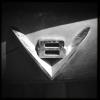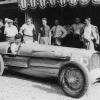
Legion Ascot Speedway
#1

Posted 01 April 2004 - 15:36
Were the grandstands really burned down by Randolph Hearst's henchmen, as the article implies?
Why? Why was Hearst so opposed to the Speedway and racing in general (did it spoil his view from Xanadu?).
Why so many fatalities? In the few photos I have found, it looks pretty much like just another oval. How come the figures are so bad?
Is there anything left of the circuit?
Any info, photos, anecdotes or history are welcome.
Edward.
Advertisement
#2

Posted 01 April 2004 - 16:45
There's a book about the Speedway, published circa 1982, but I cannot now remember the author.Originally posted by SEdward
Why was Hearst so opposed to the Speedway and racing in general (did it spoil his view from Xanadu?).
Why so many fatalities? In the few photos I have found, it looks pretty much like just another oval. How come the figures are so bad?
I'm guessing Hearst was only against motor racing because he could sell papers with moral indignation. The drivers reciprocated by beating up his reporters at funerals.
Were the figures that bad there, or were they bad everywhere? I think it was bigger and faster with flatter turns, which was not a good combo.
#3

Posted 01 April 2004 - 16:56
But I remember this was being reviewed on TNF already, as one of the most erratic books ever. Does anybody want to make an errata? I'd be interested in the results.
#4

Posted 02 April 2004 - 10:58
Lucero quotes Dr. Loring, head of the Legion's contest board: "He (Hearst) was a sensationalist. I don't feel that he really wanted to close the track. I never thought of him that way. He was strictly a sensationalist...that's how he built his empire. We didn't like the bad publicity, but most of us felt no animosity towards him".
Sounds pretty tame. My knowledge beyond the Lucero book is limited, so I can't really judge, what is true. Anyway, if the Speedway was already closed, what should been Hearst's motivation to burn it down?
#5

Posted 03 April 2004 - 02:59
-William
#6

Posted 03 April 2004 - 03:04
#7

Posted 03 April 2004 - 04:13
Not to be confused with today's fully-equipped hospital-on-wheels ambulances and helicopters manned by well-trained EMTs and paramedics who are light-years ahead of the attendants available in the "good old days".
#8

Posted 03 April 2004 - 12:42
Originally posted by WDH74
Ascot was a dirt track, right? Not paved or board. I don't have any numbers to hand, but I've always been under the impression that, at the time, the board surfaced tracks were more dangerous than dirt or paved. What with the splinters, the holes, carpenters sticking their heads through the holes during a race to patch them up, wood warpage, and the polished dance floor surface, they'd be a darn sight more difficult to drive on. On the other paw, I've only seen a few pictures of Ascot, and who knows, maybe the newer dirt ovals had rather better safety measures in place than Ascot had.
-William
Legion Ascot was a 5/8 mile oiled dirt. Much more a paved track than true dirt.
The Lucerno book has some interesting photos but are often misidentified. Overall, this book
probably has more errors per page than any other racing book I've ever read. It is unfortunate because even a poor book on a subject often prevents another, well researched book from being considered.
As for Hearst --- the organization was probably much more interested in selling newspapers than being anti-racing. It seems as tho it started around the timne Ernie Triplett was killed at El Centro. Earlier auto racing was covered in some detail by the newspaper in the LA Herald Examiner (or whatever it was called back then) without the sensationalism.
Yes, boards could be quite dangerous. A wood surface topped with oil makes for a very slippery surface. Especially since in the 1920s oil could be added during a race. Board tracks were very impressive but the racing was so-so. Flat out all the way; little dicing.
#9

Posted 03 April 2004 - 13:58
Originally posted by Buford
I think better safety in those days meant something like actually having an ambulance standing by .
Reminds me of another quote from the Lucero book (without further comment):
"Another highlight at Ascot was the introduction of the first crash helmet ever worn in competition on an American track. Crash helmets in the U.S. were unheard of at this time, and every driver used the old style cloth headpiece under his strapped goggles. Wilbur Shaw, who was to win three Indianapolis races, then received a gift, that was to set the safety standard for all present and future drivers.
"The gift was a crash helmet, given to Wilbur in the spring of 1932, by Major H.O.D. Segrave, of England. Thus, Wee Wilbur became the first man to wear such a helmet on a U.S. track.
"Shaw was resoundingly booed when he first wore the helmet. He was heckled by the speed thirsty fans and sometimes called "chicken". Many Ascot drivers refused to wear the helmet, for fear they would lose prestige and become targets of the howling fans."
#10

Posted 03 April 2004 - 17:19
Pretty simple, actually: because Legion Ascot saw a race meeting almost every other weekend, and thus probably more race activity than all the other tracks in the world combined!Originally posted by SEdward
Why so many fatalities? In the few photos I have found, it looks pretty much like just another oval. How come the figures are so bad?
Same with Indianapolis: one "500" lasts a whole month, and there were mostly five or six dozen cars entered, so that the miles covered in practice, qualifying and race at Indy equalled a full Formula One season.
Neither Indianapolis Motor Speedway nor Legion Ascot Speedway were any more dangerous than any other track in the world.
#11

Posted 03 April 2004 - 21:56
-William
#12

Posted 03 April 2004 - 22:47
I got off the track and spotted my yellow van and decided that must be where I was going but I smashed into the back of the trailer at about 20 MPH because there were no brakes. I got out and people ran up. Everybody was asking me if I was alright and I knew I wasn't but I kept saying I was because I did not want them to know I did not know who I was or anything.
USAC was at the top level of safety and I do recall a girl dressed in white who was a nurse or paramedic talking to me and acting concerned. But nobody asked me my name or the day of the week or anything and they were talking about the accident and I thought they were talking about the trailer accident. I didn't even remember the one before that! I finally got away from them and walked over to the wall and watched the cars, trying to figure out what was going on. It took about a half hour before it all came back, and then a few hours later when I was driving home I had to pull over and stop because I realized I did not know where I was or where I was going. I had an Atlas and I tried to look at it but it was useless because it had a whole bunch of pages and I did not know which one to look at. After about 10 minutes I remembered where I was and where I was going.
In 1979 when I flipped my Sprint Car and blew up in a fireball, there was no fire bottles on the corner, no crash crew at all, and a guy from the infield ran through the flames to drag me out of the car although I was OK and doing it myself at that point. No medical people ever showed up, we had to throw dirt on the fire and it was a big one. Finally a couple fire bottles arrived and one didn't work. The last chance one put out the fire. I walked back, no medical people ever talked to me, and I was in the car an hour later and ready to be pushed off again when we decided not to run because fire powder may have gotten into the engine. The car had not suffered much damage and nobody told me I could not get back in and nobody ever did any kind of medical check on me even though it had been a pretty big accident.
#13

Posted 05 April 2004 - 00:37
Originally posted by fines
Pretty simple, actually: because Legion Ascot saw a race meeting almost every other weekend, and thus probably more race activity than all the other tracks in the world combined!
Same with Indianapolis: one "500" lasts a whole month, and there were mostly five or six dozen cars entered, so that the miles covered in practice, qualifying and race at Indy equalled a full Formula One season.
Neither Indianapolis Motor Speedway nor Legion Ascot Speedway were any more dangerous than any other track in the world.
To put this in perspective, in 1932 Legion Ascot held 38 race dates. The First was Jan 10th and the last of the year was Dec 18th. Except for special events, all of their races were on Wednesday night. Can you imagine a track today being successful with a regular Wednesday program. The purses, due to the American Legion's promotional efforts, were very high for the day. The top drivers were well paid, to day the least.
Legion Ascot's fatality per racedate numbers were much lower than any other track for the reason Fines pointed out. What's Indianapolis' number? --- 1 per every two races when you count spectators, mechanicians, etc.
#14

Posted 05 April 2004 - 23:17
Your philosophy on the track and mine in RVN were the same: if it's not your day, it's not your day. Don't spend time worrying about it; just go out and do Your Thing as best you can. If the Fickle Finger should point at you, then at least you went out trying.
It remains my philosophy today, and I imagine it's yours as well.
#15

Posted 06 April 2004 - 00:50
#16

Posted 24 May 2013 - 06:42
http://www.elsereno9...ot_Speedway.php
#17

Posted 24 May 2013 - 15:28
#18

Posted 24 May 2013 - 16:17
#19

Posted 24 May 2013 - 16:19
First, this 2004 article on Rex Mays in MotorSport implying Hearst's goons burned down the stands...let me guess who wrote that
Sad to see these myths persisting that recently. Despite the number of times this has been repeated, William Randolph Hearst seemed to have little influence on the closing of the track. The real reason was entirely different, and far less exciting...apparently.
From my digging, Hearst's Los Angeles papers could be sensationalistic, but generally I haven't found them to be anti-racing. Granted, there's still ground to cover, but I've yet to run across an anti-racing editorial in any of Hearst's Los Angeles papers. There's the infamous graphic editorial cartoon that was anti-racing, but that apparently was post-WWII and published in the New York World. The single worst piece I've run across, so far, was one in the Los Angeles Times.
I'm hoping/planning on an article about some of the fallacies surrounding (Legion) Ascot Speedway, but...I'd have to find someone willing to publish it versus continuing to print the myths. Still needs some research, but again...who'll publish it?
Even the funeral incident seems greatly overstated, but I'm trying to get as many details as possible. Hearst's papers were outraged, but soon found bigger stories. As for the track, it was banked, fairly steeply, which kept speeds high and caused great problems for any driver unfortunate enough to go over the south turn railing to plummet or tumble down a steep embankment.I'm guessing Hearst was only against motor racing because he could sell papers with moral indignation. The drivers reciprocated by beating up his reporters at funerals.
Were the figures that bad there, or were they bad everywhere? I think it was bigger and faster with flatter turns, which was not a good combo.


















